stress & anxiety support

free shipping over $100 (USA & Canada)
1-877-937-4372 the pet expert hotline

Natural Help for Stress Reduction, Anxiety Relief, Behavioral Problems, and Aggression in Cats

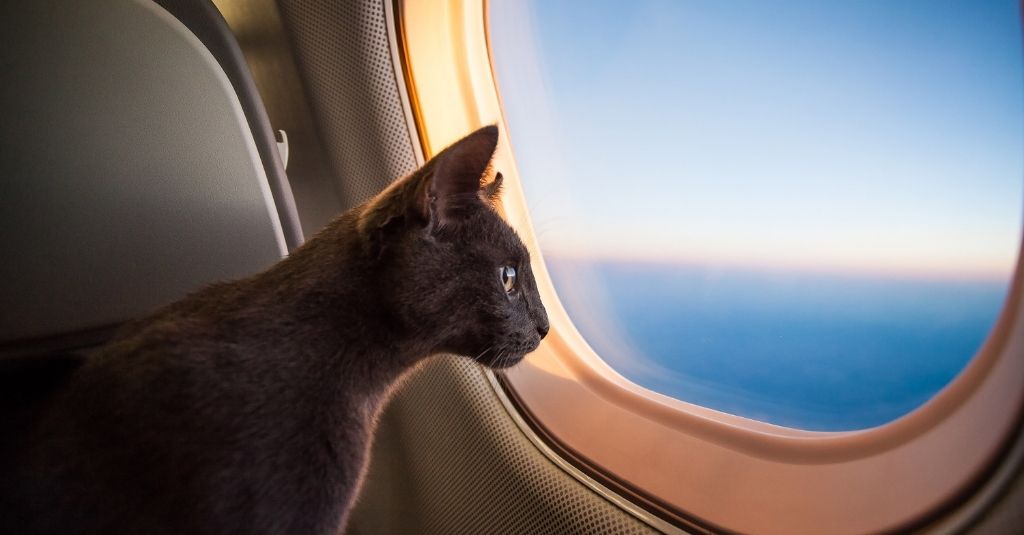
Now that travel is starting to open up again, you may be planning or daydreaming about taking a trip. Whether you’re traveling by car or jet-setting to some far-off destination, it’s important to plan ahead to account for your pets. It takes preparation to find the right pet sitter or to make all of the necessary arrangements to bring your pet along for the journey. Here are our tips on what you should know if you are going to fly with pets.
It is important to start planning your pet’s trip well in advance. If you want to travel with your furry companion, your best resource is the website of each flight company that you are considering and the website of the embassy of the country you are traveling to. Even if it is a domestic flight, you should consult the local embassy website to check the rules.
You must know that all the vaccines should be up to date, and some flight companies require that the vaccinations be given at least a month prior to the flight date, up to a year. Some companies and countries also require deworming and external parasite prevention. Vaccines usually include rabies and distemper for dogs, and rabies and feline distemper (feline panleukopenia) for cats. Please note that some countries may require more types of vaccines and most, if not all, countries, require the rabies vaccine.
Each company and country has its own rules for flying with pets.
Flying with your pet may sound fun, but it requires planning and willingness to spend hours researching and, often, paying for veterinarian documentation and flight fee.
Each company has its own rules and restrictions for flying with a pet. And more importantly, each country has its own requirements as well, which can vary from a simple document to quarantine and expensive tests. So, start planning months ahead, as sometimes the whole process can take up to six months of performing exams and gathering documents.
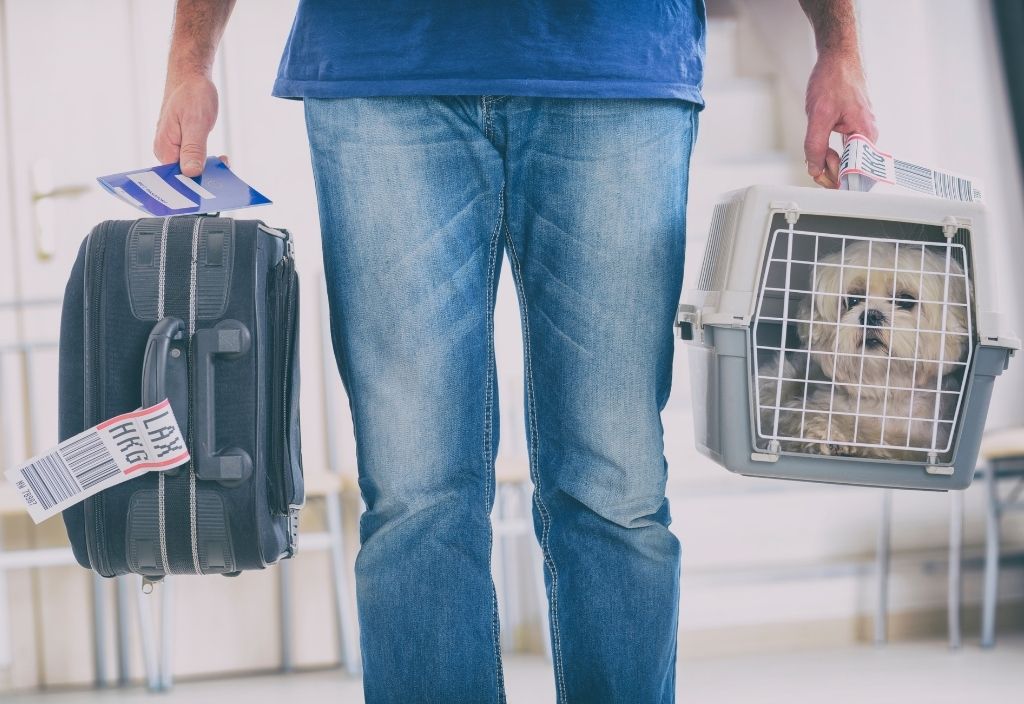
When you are familiar with all the rules and regulations, pay attention to deadlines. When to book your pet’s flight and how to prepare. Flying can be stressful and depending on the flight company and size of your pet, they may have to travel in a separate compartment, other than with you in the main cabin. Either way, the same preparations are suggested:
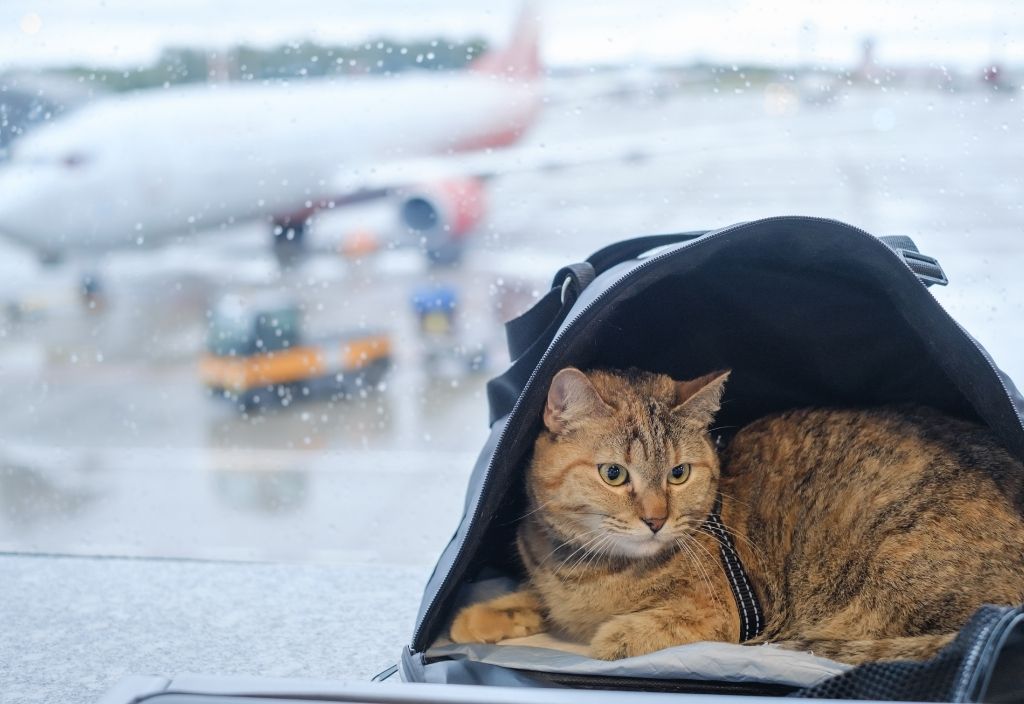
We recommend you pack sealed supplements for the trip. Because our supplements don’t have any type of preservatives, they must be kept refrigerated after they are opened, so it is not a good idea to put them inside of a suitcase for longer periods if they are opened. If they are sealed, just make sure they are well packed and there is no risk of breaking them.
The supplements we recommend to help your pets keep calm are Matricalm and Lesstress. Both are vet formulated with herbs that help with stress and anxiety.
Matricalm is an all-natural supplement that provides anxiety and stress relief in cats and dogs and promotes calm behavior. It can help calm aggression and reduces agitation. Its gentle yet effective formula is safe for long-term use.
Lesstress is our natural support for canine stress and anxiety. Because it is a calming formula, it can also help with discomfort. Lesstress is also formulated to be safe for long-term use.
During the flight, if your pet is traveling with you in the cabin, it is possible to put your hand inside the carrier to keep them calm. Some companies will not allow you to open the carrier or have it on your lap at any time, so it is important to ask if you can do it or not. As a protocol, pets are to be always kept inside the carriers, underneath your seat. Make sure your pet is comfortable inside the carrier and can have enough space to move around inside.
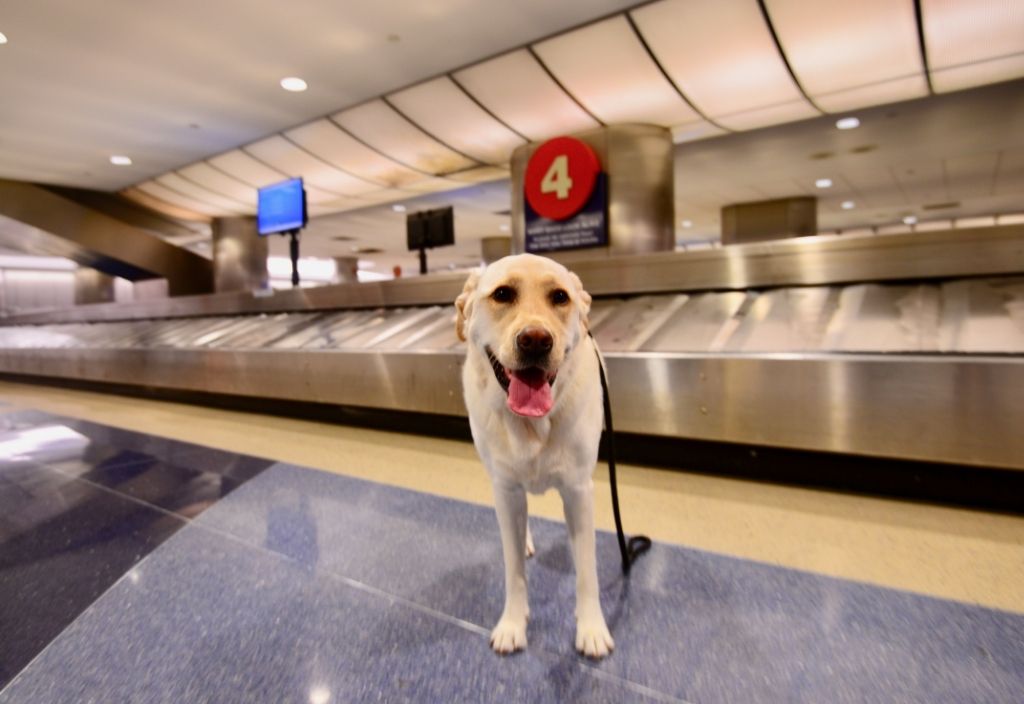
Once you arrive at your destination, take your pet for a brief walk so they can pee and poop if they want to. Some airports offer a “pet washroom” and this information should be available on their website. Offer some water and cuddle them a little bit. If it is a connecting flight and you still must face another trip, do not offer too much food. Sometimes it is better for them to eat less than what they are used to, to avoid diarrhea and an upset stomach.
When you are finally at your destination, let your pet get used to the place they are going to stay in. Let them sniff around and adjust to the new environment and possible new home. They may appear more tired in the first days, but they should adjust well and get back to their normal behavior after they have had some time to adjust.
We hope you have a safe trip with your pet and we are here to help you if you need us! If you have any questions, feel free to reach out to our team of pet experts using the chat button below.
stress & anxiety support

Natural Support for Canine Stress and Anxiety
buy 2 and save $3
3 month supply for a small to medium size pet
Everyone knows what stress feels like, and we all know that too much stress can make us ill—high blood pressure, ulcers and even cancer can result from excessive stress. Like us, dogs can get stressed by numerous factors as well. Help your furkiddo relax into a long and happy life with NHV Lesstress - a natural dog stress support.


Everyone knows what stress feels like, and we all know that too much stress can make us ill—high blood pressure, ulcers and even cancer can result from excessive stress. Like us, dogs can get stressed by numerous factors as well. Help your furkiddo relax into a long and happy life with NHV Lesstress - a natural dog stress support.

Natural Dog Stress Reliever Supplemental Support
With a heightened sense of hearing and smell, small events that seem mundane to us can be terrifying and stressful for your dogs. Sometimes the stress is from the ride to the office, or maybe they are missing their human companions. This all contributes to changes in behavior like excessive panting, drooling, sweaty paws, dilated eyes, pacing, excessively shedding, or just completely shutting down. Some dogs become so stressed that it may lead to fear and aggression.
Other forms of stress in a dog’s life include:
In addition to panting, excessive barking/whining, chewing on themselves, shivering (when it’s not cold), panicked tail wagging, or tense muscles, stress can also cause GI tract issues such as diarrhea or vomiting.
The key to a healthy pup is balance. Too much or too little activity can be harmful, as well as too much or too little socialization. A balanced, clean diet also helps maintain the body and the mind. If your dog is susceptible to stress, you can use calming herbs like those found in NHV Lesstress. This formulation gently acts on the nervous system and immune system to provide a natural dog stress reliever.
How NHV’s Natural Dog Stress Relief Eases Stress and Anxiety
For stressful experiences such as separation anxiety, the loss or addition of a furry friend, special events (eg. fireworks) and illness (stress can cause conditions to worsen), the natural (non-addictive) sedative properties of Lesstress gently relax the nervous system and endocrine system. Ingredients like Chamomile, Passion Flower and Lemon Balm work to calm nerves while ingredients like Reishi, Eleuthero, and Echinacea Angustifolia are very beneficial for helping the body adapt to stress and illness and stimulate healthy immune function.
Help Support Your Dog Naturally
All NHV supplements like Lesstress are 100% natural and created by a holistic veterinarian and a master herbalist, specially formulated for pets. Feel free to contact our veterinary professionals to get more insight into your little one’s health and wellbeing.
Made with the finest, organically grown, or ethically harvested herbs. Made specifically for pets, vet-formulated and vet approved.
Lesstress for Dogs
Select your pet's weight to determine the correct dose.
To be taken twice daily. Determine your pet’s weight and then use the easy chart below to determine the correct dose. This is the minimum dosage.
Pet's Weight Dosage
0 - 15 lb = 0.5 ml
16 - 30 lb = 1.0 ml
31 - 45 lb = 1.5 ml
46 - 60 lb = 2.0 ml
61 - 75 lb = 2.5 ml
Over 75 lb = 3.0 ml
For small animals (rabbits, ferrets), avians and reptiles use 1 drop for every 2 lb of body weight.
How to Administer
Shake well before use.
The easiest method is to use the dropper provide and places the drops into your pet’s food or favorite treat. You can also use the dropper and squirt directly into the pet’s mouth.
Some pets can be finicky, if this occurs consider hiding the drops in foods most pet’s love such as fish, chicken or yogurt or a favourite treat. If your pet only eats dry food then soak a few kibbles at feeding time.
For Best Results
Herbal dietary supplements are beneficial to the health and wellbeing of your pet and are safe for long-term use. Every pet responds to natural herbal supplements differently, therefore it is important to be consistent and administer the product daily. Supplements generally take two to four weeks to take effect, however this will vary from one animal to the next.
Product Storage
All NHV Natural Pet Products are pure herbal extracts and contain no artificial additives, preservatives or coloring. Shelf life after opening is 6 months and must be refrigerated after opening.
Cautions and Contraindications
Do not use Lesstress in pregnant or nursing animals.
Speak to your vet before using our products. A second visit is recommended if your pet’s condition does not improve, or deteriorates after continued use of the supplements.
All information provided by NHV Natural Pet Products is for educational purposes only.
Natural Dog Stress Reliever Supplemental Support
With a heightened sense of hearing and smell, small events that seem mundane to us can be terrifying and stressful for your dogs. Sometimes the stress is from the ride to the office, or maybe they are missing their human companions. This all contributes to changes in behavior like excessive panting, drooling, sweaty paws, dilated eyes, pacing, excessively shedding, or just completely shutting down. Some dogs become so stressed that it may lead to fear and aggression.
Other forms of stress in a dog’s life include:
In addition to panting, excessive barking/whining, chewing on themselves, shivering (when it’s not cold), panicked tail wagging, or tense muscles, stress can also cause GI tract issues such as diarrhea or vomiting.
The key to a healthy pup is balance. Too much or too little activity can be harmful, as well as too much or too little socialization. A balanced, clean diet also helps maintain the body and the mind. If your dog is susceptible to stress, you can use calming herbs like those found in NHV Lesstress. This formulation gently acts on the nervous system and immune system to provide a natural dog stress reliever.
How NHV’s Natural Dog Stress Relief Eases Stress and Anxiety
For stressful experiences such as separation anxiety, the loss or addition of a furry friend, special events (eg. fireworks) and illness (stress can cause conditions to worsen), the natural (non-addictive) sedative properties of Lesstress gently relax the nervous system and endocrine system. Ingredients like Chamomile, Passion Flower and Lemon Balm work to calm nerves while ingredients like Reishi, Eleuthero, and Echinacea Angustifolia are very beneficial for helping the body adapt to stress and illness and stimulate healthy immune function.
Help Support Your Dog Naturally
All NHV supplements like Lesstress are 100% natural and created by a holistic veterinarian and a master herbalist, specially formulated for pets. Feel free to contact our veterinary professionals to get more insight into your little one’s health and wellbeing.
Made with the finest, organically grown, or ethically harvested herbs. Made specifically for pets, vet-formulated and vet approved.
Lesstress for Dogs
Select your pet's weight to determine the correct dose.
To be taken twice daily. Determine your pet’s weight and then use the easy chart below to determine the correct dose. This is the minimum dosage.
Pet's Weight Dosage
0 - 15 lb = 0.5 ml
16 - 30 lb = 1.0 ml
31 - 45 lb = 1.5 ml
46 - 60 lb = 2.0 ml
61 - 75 lb = 2.5 ml
Over 75 lb = 3.0 ml
For small animals (rabbits, ferrets), avians and reptiles use 1 drop for every 2 lb of body weight.
How to Administer
Shake well before use.
The easiest method is to use the dropper provide and places the drops into your pet’s food or favorite treat. You can also use the dropper and squirt directly into the pet’s mouth.
Some pets can be finicky, if this occurs consider hiding the drops in foods most pet’s love such as fish, chicken or yogurt or a favourite treat. If your pet only eats dry food then soak a few kibbles at feeding time.
For Best Results
Herbal dietary supplements are beneficial to the health and wellbeing of your pet and are safe for long-term use. Every pet responds to natural herbal supplements differently, therefore it is important to be consistent and administer the product daily. Supplements generally take two to four weeks to take effect, however this will vary from one animal to the next.
Product Storage
All NHV Natural Pet Products are pure herbal extracts and contain no artificial additives, preservatives or coloring. Shelf life after opening is 6 months and must be refrigerated after opening.
Cautions and Contraindications
Do not use Lesstress in pregnant or nursing animals.
Speak to your vet before using our products. A second visit is recommended if your pet’s condition does not improve, or deteriorates after continued use of the supplements.
All information provided by NHV Natural Pet Products is for educational purposes only.
travel support

Matricalm, Heal Care Ointment, Target Spray
bundle and save with pet expert kits
3 month supply for a small to medium size
Our Travel Essentials kit includes products essential for the travelling pet. Keep your pet calm, free of fleas, ticks and mosquitos and soothe damaged or burnt skin

Our Travel Essentials kit includes products essential for the travelling pet. Keep your pet calm, free of fleas, ticks and mosquitos and soothe damaged or burnt skin
Help reduce aggression and anxiety in your pet with Matricalm, a natural herbal product designed to help reduce excitability in your pet. Pets can become anxious or aggressive when exposed to other animals or to people they are unfamiliar with. Separation from an owner or a move to a new home can also trigger troubling symptoms of anxiety
Safely rid your pet of insects and their eggs. Target Spray helps your pet rid itself of fleas, ticks, lice, and mosquitoes. Its soothing herbal formulation keeps insects away and calms skin irritated by the inevitable scratching bugs cause. Fleas are tiny, wingless insects that feed on your pet’s body by sucking blood. They can transmit disease, cause skin allergies, anemia, and generally irritate your pet. Many pets are allergic to flea saliva, which causes them to lick, chew, scratch, and rub the irritated area. This can often result in hair loss and secondary infections.
Many pets are busy animals prone to paw or skin injuries including bruising, sprains, cuts, wounds, burns and infections. Signs of injury are easy to spot and include obvious discomfort, limping, red and swollen pads, and a general reluctance to walk or run. Heal Care Ointment is a topical ointment designed to soothe and heal injured paws and skin.
MATRICALM
Chamomile – Contains sedative properties.
Passion Flower – An effective, non-addictive sedative.
Lemon Balm – An aromatic herb used for nervous disorders, excitability, and anxiety.
Valerian – Stops heart palpitations, relaxes spasms, relieves discomfort, and regulates the nervous system.
Hops – Eases tension and anxiety in pets.
HEAL CARE OINTMENT
Arnica – Relieves discomfort and inflammation, clears fungal and bacterial infections, and stimulates the immune system.
St. John’s Wort – Reduces inflammation, promotes healing, and acts as an antiseptic and analgesic.
TARGET SPRAY
Lavender – Contains volatile oils of low toxicity and tannins with antiseptic and insect deterrent action.
Rosemary – Rich in essential oils. Also has antiseptic, astringent, and anti-inflammatory properties.
Sweet-Scented Marigold – An effective insect deterrent that also helps eliminate ticks.
Neem – An effective insect deterrent that helps eliminate parasites and has significant healing properties.
European Pennyroyal – An insect deterrent that also soothes itchy skin.
Aloe Vera – Soothes and cools irritated skin.
Celandine –Protects the liver and can help against microorganisms.
Milk Thistle – Protects the liver from toxins.
Lemongrass Oil – An effective insect deterrent that contains essential oils.
Ceylon Citronella Oil – An insect deterrent that contains antiviral and antibacterial properties.
Tea Tree Oil – An effective antiseptic useful in the treatment of wounds and bites.
Select your pet's weight to determine the correct dose.
DOSAGE FOR MATRICALM
To be taken twice daily. Determine your pet’s weight and then use the easy chart below to determine the correct dose. This is the minimum dosage.
Pet's Weight Dosage
0 - 15 lb = 0.5 ml
16 - 30 lb = 1.0 ml
31 - 45 lb = 1.5 ml
46 - 60 lb = 2.0 ml
61 - 75 lb = 2.5 ml
Over 75 lb = 3.0 ml
For small animals (rabbits, ferrets), avians and reptiles use 1 drop for every 2 lb of body weight.
How to Administer
Shake well before use. The easiest method is to use the dropper provided and place the drops into your pet’s food or favorite treat. You can also use the dropper and squirt directly into the pet’s mouth. Some pets can be finicky, if this occurs consider hiding the drops in foods most pet’s love such as fish, chicken or yogurt or a favorite treat. If your pet only eats dry food then soak a few kibbles at feeding time.
For Best Results
Herbal dietary supplements are beneficial to the health and well-being of your pet and are safe for long-term use. Every pet responds to natural herbal supplements differently, therefore it is important to be consistent and administer the product daily. Supplements generally take two to four weeks to take effect, however this will vary from one animal to the next.
Product Storage
All NHV Natural Pet Products are pure herbal extracts and contain no artificial additives, preservatives or coloring. Shelf life after opening is 6 months and must be refrigerated after opening.
Cautions and Contraindications
Do not use in pregnant or nursing animals.
All information provided by NHV Natural Pet Products is for educational purposes only.
TARGET SPRAY
How to Administer
Topical Spray: Spray several times a day as need. It may some times be necessary to shave or trim your pet’s hair so that the Target spray reaches the affected area.
Caution
Do not spray near or into eyes or nose. Do not use in pregnant animals.
HEAL CARE OINTMENT
How to Administer
Topical ointment: Clean and dry paw pads. Apply to affected area 3 to 4 times per day until healed. It may be necessary to use booties or wrap the paw with gauze dressing so that your pet does not lick the ointment.
Caution
Do not apply on open or bleeding wounds. Heal Care ointment contains arnica which may cause a skin allergy on some very sensitive pet’s. Try the product on a hairless part of the body first to test for sensitivity
Help reduce aggression and anxiety in your pet with Matricalm, a natural herbal product designed to help reduce excitability in your pet. Pets can become anxious or aggressive when exposed to other animals or to people they are unfamiliar with. Separation from an owner or a move to a new home can also trigger troubling symptoms of anxiety
Safely rid your pet of insects and their eggs. Target Spray helps your pet rid itself of fleas, ticks, lice, and mosquitoes. Its soothing herbal formulation keeps insects away and calms skin irritated by the inevitable scratching bugs cause. Fleas are tiny, wingless insects that feed on your pet’s body by sucking blood. They can transmit disease, cause skin allergies, anemia, and generally irritate your pet. Many pets are allergic to flea saliva, which causes them to lick, chew, scratch, and rub the irritated area. This can often result in hair loss and secondary infections.
Many pets are busy animals prone to paw or skin injuries including bruising, sprains, cuts, wounds, burns and infections. Signs of injury are easy to spot and include obvious discomfort, limping, red and swollen pads, and a general reluctance to walk or run. Heal Care Ointment is a topical ointment designed to soothe and heal injured paws and skin.
MATRICALM
Chamomile – Contains sedative properties.
Passion Flower – An effective, non-addictive sedative.
Lemon Balm – An aromatic herb used for nervous disorders, excitability, and anxiety.
Valerian – Stops heart palpitations, relaxes spasms, relieves discomfort, and regulates the nervous system.
Hops – Eases tension and anxiety in pets.
HEAL CARE OINTMENT
Arnica – Relieves discomfort and inflammation, clears fungal and bacterial infections, and stimulates the immune system.
St. John’s Wort – Reduces inflammation, promotes healing, and acts as an antiseptic and analgesic.
TARGET SPRAY
Lavender – Contains volatile oils of low toxicity and tannins with antiseptic and insect deterrent action.
Rosemary – Rich in essential oils. Also has antiseptic, astringent, and anti-inflammatory properties.
Sweet-Scented Marigold – An effective insect deterrent that also helps eliminate ticks.
Neem – An effective insect deterrent that helps eliminate parasites and has significant healing properties.
European Pennyroyal – An insect deterrent that also soothes itchy skin.
Aloe Vera – Soothes and cools irritated skin.
Celandine –Protects the liver and can help against microorganisms.
Milk Thistle – Protects the liver from toxins.
Lemongrass Oil – An effective insect deterrent that contains essential oils.
Ceylon Citronella Oil – An insect deterrent that contains antiviral and antibacterial properties.
Tea Tree Oil – An effective antiseptic useful in the treatment of wounds and bites.
Select your pet's weight to determine the correct dose.
DOSAGE FOR MATRICALM
To be taken twice daily. Determine your pet’s weight and then use the easy chart below to determine the correct dose. This is the minimum dosage.
Pet's Weight Dosage
0 - 15 lb = 0.5 ml
16 - 30 lb = 1.0 ml
31 - 45 lb = 1.5 ml
46 - 60 lb = 2.0 ml
61 - 75 lb = 2.5 ml
Over 75 lb = 3.0 ml
For small animals (rabbits, ferrets), avians and reptiles use 1 drop for every 2 lb of body weight.
How to Administer
Shake well before use. The easiest method is to use the dropper provided and place the drops into your pet’s food or favorite treat. You can also use the dropper and squirt directly into the pet’s mouth. Some pets can be finicky, if this occurs consider hiding the drops in foods most pet’s love such as fish, chicken or yogurt or a favorite treat. If your pet only eats dry food then soak a few kibbles at feeding time.
For Best Results
Herbal dietary supplements are beneficial to the health and well-being of your pet and are safe for long-term use. Every pet responds to natural herbal supplements differently, therefore it is important to be consistent and administer the product daily. Supplements generally take two to four weeks to take effect, however this will vary from one animal to the next.
Product Storage
All NHV Natural Pet Products are pure herbal extracts and contain no artificial additives, preservatives or coloring. Shelf life after opening is 6 months and must be refrigerated after opening.
Cautions and Contraindications
Do not use in pregnant or nursing animals.
All information provided by NHV Natural Pet Products is for educational purposes only.
TARGET SPRAY
How to Administer
Topical Spray: Spray several times a day as need. It may some times be necessary to shave or trim your pet’s hair so that the Target spray reaches the affected area.
Caution
Do not spray near or into eyes or nose. Do not use in pregnant animals.
HEAL CARE OINTMENT
How to Administer
Topical ointment: Clean and dry paw pads. Apply to affected area 3 to 4 times per day until healed. It may be necessary to use booties or wrap the paw with gauze dressing so that your pet does not lick the ointment.
Caution
Do not apply on open or bleeding wounds. Heal Care ointment contains arnica which may cause a skin allergy on some very sensitive pet’s. Try the product on a hairless part of the body first to test for sensitivity
diarrhea support

Natural relief to help your cat’s diarrhea and inflammatory bowel syndrome (IBS)
buy 2 and save $3
3 month supply for a small to medium size pet
Does your cat have diarrhea or loose stools? NHV Plantaeris is a natural vet-formulated supplement designed to gently help support normal bowel functions, while soothing and relieving spasms of the digestive tract.


Does your cat have diarrhea or loose stools? NHV Plantaeris is a natural vet-formulated supplement designed to gently help support normal bowel functions, while soothing and relieving spasms of the digestive tract.

Plantaeris is a gentle, natural vet-formulated supplement to help cat diarrhea. It is designed to help reduce symptoms of diarrhea and maintain normal bowel function. It also helps soothe and relieve spasms, and discomfort. Since this herbal formulation helps balance the body, it can be used on a longer-term basis if your cat suffers from frequent diarrhea (though it is vital to understand the underlying cause of diarrhea).
Diarrhea is a symptom of digestive disorders. In cats, it can be caused by inflammatory bowel disease, food allergies, parasites, or commonly an underlying condition, such as hyperthyroidism or kidney disease.
To help with cat diarrhea, make sure your pet is getting adequate water and nutrition as diarrhea can lead to weight loss, dehydration, vomiting, and lethargy. Remember that a cat can be eating the same food for years and still develop a food allergy to it. Talk to your vet to rule out any underlying conditions.
For days when your cat is suffering from acute diarrhea, the Plantaeris dosage may be safely doubled. You can then bring down the dosage to normal after the episode has passed. Try adding a bit of pumpkin to their diet to help bulk up stools.
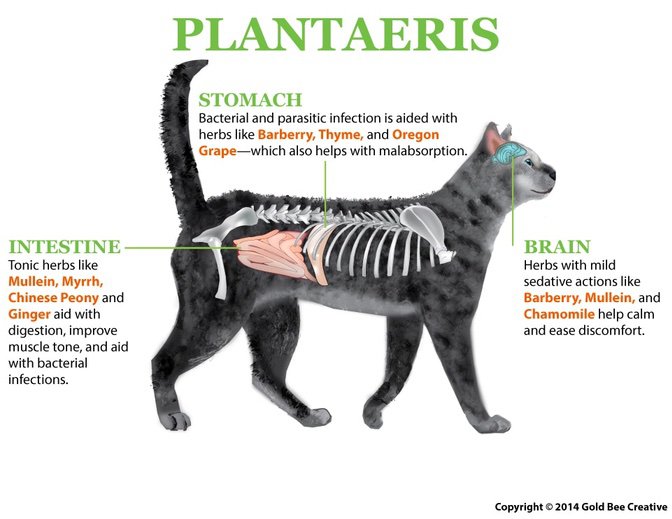
Barberry – Has traditionally been used to treat diarrhea, relieve stomach upset, and to reduce stomach acid.
Mullein – Soothes and lubricates tissues. Mullein’s medicinal properties help fight diarrhea-causing bacteria.
Bayberry – Contains tannins, resins, and gums that control bacterial infection.
Myrrh – Relieves spasms, inflammation, and digestive discomfort.
Thyme – Improves digestion and relaxes spasms. Thyme has traditionally been used to help expel gas, expel worms, and to help with IBD and colitis.
Chamomile – Relaxes the digestive system. It helps expel gas and helps reduce vomiting caused by IBD and is helpful with indigestion.
Chinese Peony – Reduces inflammation and relaxes spasms.
Ginger – Relieves discomfort and stimulates circulation. The enzymes in ginger encourage the production of gastric juices required for digestion. It helps reduce muscle contractions of the bowel, which helps eliminate waste without causing discomfort.
Oregon Grape – Helps relieve indigestion and malabsorption.
Select your pet's weight to determine the correct dose.
To be taken twice daily. Determine your pet’s weight and then use the easy chart below to determine the correct dose. This is the minimum dosage.
Pet's Weight Dosage
0 - 15 lb = 0.5 ml
16 - 30 lb = 1.0 ml
31 - 45 lb = 1.5 ml
46 - 60 lb = 2.0 ml
61 - 75 lb = 2.5 ml
Over 75 lb = 3.0 ml
How to Administer
Shake well before use. The easiest method is to use the dropper provided and place the drops into your pet’s food or favorite treat. You can also use the dropper and squirt directly into the pet’s mouth.
Some pets can be finicky. If this occurs consider hiding the drops in foods most pets love, such as fish, chicken, yogurt or a favorite treat. If your pet only eats dry food then soak a few kibbles at feeding time.
For Best Results
Herbal dietary supplements are beneficial to the health and wellbeing of your pet and are safe for long-term use. Every pet responds to natural herbal supplements differently, therefore it is important to be consistent and administer the product daily. Supplements generally take two to four weeks to take effect; however, this will vary from one animal to the next.
Product Storage
All NHV Natural Pet Products are pure herbal extracts and contain no artificial additives, preservatives or coloring. Shelf life after opening is 6 months and products must be refrigerated after opening.
Cautions and Contraindications
Do not use Plantaeris in pregnant or nursing animals. Speak to your vet before using our products. A second visit is recommended if your pet’s condition does not improve, or deteriorates after continued use of the supplements.
All information provided by NHV Natural Pet Products is for educational purposes only.
Plantaeris is a gentle, natural vet-formulated supplement to help cat diarrhea. It is designed to help reduce symptoms of diarrhea and maintain normal bowel function. It also helps soothe and relieve spasms, and discomfort. Since this herbal formulation helps balance the body, it can be used on a longer-term basis if your cat suffers from frequent diarrhea (though it is vital to understand the underlying cause of diarrhea).
Diarrhea is a symptom of digestive disorders. In cats, it can be caused by inflammatory bowel disease, food allergies, parasites, or commonly an underlying condition, such as hyperthyroidism or kidney disease.
To help with cat diarrhea, make sure your pet is getting adequate water and nutrition as diarrhea can lead to weight loss, dehydration, vomiting, and lethargy. Remember that a cat can be eating the same food for years and still develop a food allergy to it. Talk to your vet to rule out any underlying conditions.
For days when your cat is suffering from acute diarrhea, the Plantaeris dosage may be safely doubled. You can then bring down the dosage to normal after the episode has passed. Try adding a bit of pumpkin to their diet to help bulk up stools.

Barberry – Has traditionally been used to treat diarrhea, relieve stomach upset, and to reduce stomach acid.
Mullein – Soothes and lubricates tissues. Mullein’s medicinal properties help fight diarrhea-causing bacteria.
Bayberry – Contains tannins, resins, and gums that control bacterial infection.
Myrrh – Relieves spasms, inflammation, and digestive discomfort.
Thyme – Improves digestion and relaxes spasms. Thyme has traditionally been used to help expel gas, expel worms, and to help with IBD and colitis.
Chamomile – Relaxes the digestive system. It helps expel gas and helps reduce vomiting caused by IBD and is helpful with indigestion.
Chinese Peony – Reduces inflammation and relaxes spasms.
Ginger – Relieves discomfort and stimulates circulation. The enzymes in ginger encourage the production of gastric juices required for digestion. It helps reduce muscle contractions of the bowel, which helps eliminate waste without causing discomfort.
Oregon Grape – Helps relieve indigestion and malabsorption.
Select your pet's weight to determine the correct dose.
To be taken twice daily. Determine your pet’s weight and then use the easy chart below to determine the correct dose. This is the minimum dosage.
Pet's Weight Dosage
0 - 15 lb = 0.5 ml
16 - 30 lb = 1.0 ml
31 - 45 lb = 1.5 ml
46 - 60 lb = 2.0 ml
61 - 75 lb = 2.5 ml
Over 75 lb = 3.0 ml
How to Administer
Shake well before use. The easiest method is to use the dropper provided and place the drops into your pet’s food or favorite treat. You can also use the dropper and squirt directly into the pet’s mouth.
Some pets can be finicky. If this occurs consider hiding the drops in foods most pets love, such as fish, chicken, yogurt or a favorite treat. If your pet only eats dry food then soak a few kibbles at feeding time.
For Best Results
Herbal dietary supplements are beneficial to the health and wellbeing of your pet and are safe for long-term use. Every pet responds to natural herbal supplements differently, therefore it is important to be consistent and administer the product daily. Supplements generally take two to four weeks to take effect; however, this will vary from one animal to the next.
Product Storage
All NHV Natural Pet Products are pure herbal extracts and contain no artificial additives, preservatives or coloring. Shelf life after opening is 6 months and products must be refrigerated after opening.
Cautions and Contraindications
Do not use Plantaeris in pregnant or nursing animals. Speak to your vet before using our products. A second visit is recommended if your pet’s condition does not improve, or deteriorates after continued use of the supplements.
All information provided by NHV Natural Pet Products is for educational purposes only.
Published: August 25, 2021